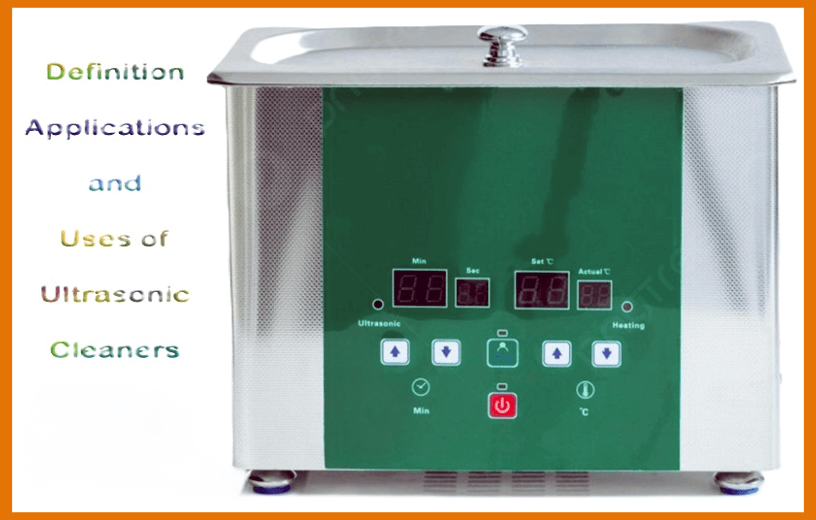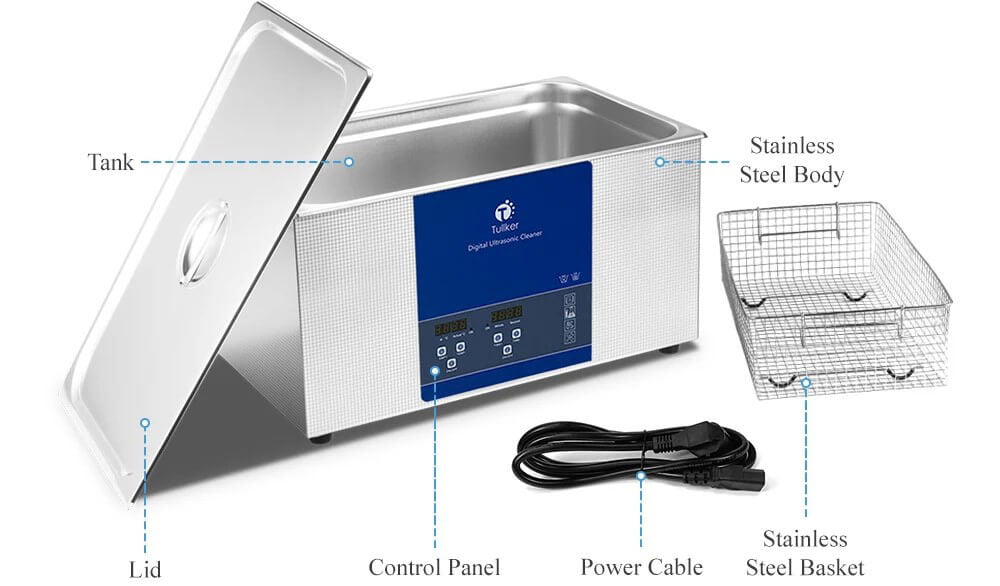- Water Testing Meters
- Anemometer
- Length & Distance Meter
- Multimeter & Clamp Meter
- Light and Sound Meter
- Slide Calipers & Screw Gauge
- Thermometer & Hygrometer
- Milk Testing Meters
- Paper, Grain & Wood Testers
- Stopwatch & Timers
- Soil Testing Meters
- Refractometers & Analyzer
- Magnetic Compass
- Tachometer & Megger
- Thickness & Dia-Meters
- Other Meter And Accessories
Definition, Applications, and Uses of Ultrasonic Cleaners

An ultrasonic cleaner is a device that utilizes ultrasonic sound waves to clean objects. Read this article to learn the definition, applications, and uses of ultrasonic cleaners in the Laboratory.
An ultrasonic cleaner consists of a tank filled with a cleaning solution, typically water or a solvent, and an ultrasonic transducer. When the transducer emits high-frequency sound waves (typically above the range of human hearing, around 20 to 400 kHz), it creates millions of tiny bubbles through a process called cavitation. These bubbles implode near the surface of the object being cleaned, effectively dislodging contaminants such as dirt, grease, oil, and debris.

The process of cavitation creates intense scrubbing action on the surface of the object, allowing for thorough cleaning even in hard-to-reach areas and intricate details. Ultrasonic cleaners are widely used in various industries, including healthcare, laboratory research, electronics manufacturing, jewelry, automotive, and more.
Key components of an ultrasonic cleaner include:
- Tank: A container where the cleaning solution and the object to be cleaned are placed.
- Transducer: A device that converts electrical energy into mechanical vibrations, generating ultrasonic waves in the cleaning solution.
- Generator: A control unit that provides electrical power to the transducer, controlling the frequency and intensity of the ultrasonic waves.
- Cleaning Solution: A liquid solution containing detergents or solvents, which helps in the cleaning process by reducing surface tension and enhancing cavitation.
- Timer and Temperature Control: Some ultrasonic cleaners come with built-in timers and temperature control settings, allowing users to customize the cleaning process based on their specific requirements.
Ultrasonic cleaners offer several advantages over traditional cleaning methods, including:
- Efficient and thorough cleaning, even in intricate and hard-to-reach areas.
- Non-contact cleaning, minimizing the risk of damage to delicate objects.
- Reduced need for manual labor, saving time and effort.
- Environmentally friendly, as they often require less use of harsh chemicals.
- Versatile applications across various industries, from healthcare to manufacturing.
Overall, ultrasonic cleaners provide a powerful and effective solution for cleaning a wide range of objects, making them indispensable tools in many professional and industrial settings.
Applications, and Uses of Ultrasonic Cleaners in Laboratories
Ultrasonic cleaners have become indispensable tools in the Laboratory, revolutionizing the way researchers clean and prepare equipment, instruments, and samples. These powerful devices utilize high-frequency sound waves to agitate a cleaning solution, effectively removing contaminants from surfaces without causing damage. Here we are trying to explore diverse applications and uses of ultrasonic cleaners in laboratories, highlighting their importance in ensuring cleanliness, accuracy, and efficiency in scientific research and analysis.
Uses of Ultrasonic Cleaners for Cleaning Laboratory Glassware:
Laboratory glassware, such as beakers, flasks, cylinders, and test tubes, is prone to accumulating stubborn contaminants like grease, oils, and residues. Ultrasonic cleaners offer a solution by providing a thorough and efficient cleaning method. The cavitation process generated by ultrasonic waves dislodges dirt particles from the surface of glassware, ensuring it is pristine and ready for use in experiments and analyses.
Uses of Ultrasonic Cleaners for Cleaning Laboratory Instruments:
Delicate laboratory instruments, including tweezers, scissors, forceps, and probes, require meticulous cleaning to maintain their functionality and accuracy. Ultrasonic cleaners offer a gentle yet effective method for removing contaminants from instrument surfaces without causing damage. Researchers can rely on ultrasonic cleaners to ensure their instruments are free from debris, ensuring precise results in experiments and procedures.
Uses of Ultrasonic Cleaners for Cleaning Lab Equipment Parts:
Laboratory equipment, such as centrifuge rotors, microscope slides, metal sieves, and filters, often comprises intricate parts that can harbor contaminants. Ultrasonic cleaners provide a comprehensive solution for cleaning equipment components, ensuring they are free from dirt and residues. Clean equipment parts contribute to the accuracy and reliability of laboratory analyses, minimizing the risk of contamination and errors.
Uses of Ultrasonic Cleaners for Degassing Liquids
In many laboratory applications, degassing liquids is essential to remove trapped air bubbles and ensure the accuracy of results. Ultrasonic cleaners facilitate the degassing process by subjecting liquids to high-frequency vibrations, effectively releasing entrapped gases. This capability is crucial for various laboratory techniques, including sample preparation, cell culture, and chromatography, where the presence of air bubbles can compromise results.
Uses of Ultrasonic Cleaners for Cleaning Electronics:
Electronic components and circuit boards used in laboratory instruments require meticulous cleaning to maintain their performance and longevity. Ultrasonic cleaners offer a safe and efficient method for removing contaminants from electronic surfaces without causing damage. Researchers can rely on ultrasonic cleaners to clean spectrophotometers, pH meters, conductivity meters, and other sensitive electronic devices, ensuring optimal functionality and accuracy.
Uses of Ultrasonic Cleaners for Cleaning Surgical Instruments:
In research and medical laboratories, surgical instruments must undergo thorough cleaning and sterilization to prevent contamination and ensure patient safety. Ultrasonic cleaners play a crucial role in this process by effectively removing contaminants from surgical tools, such as scalpels, forceps, and dental instruments. By utilizing ultrasonic technology, laboratories can achieve high levels of cleanliness and sterility, minimizing the risk of infections and cross-contamination.
Uses of Ultrasonic Cleaners for Preparation of Samples:
Ultrasonic cleaners play a vital role in sample preparation for various analytical techniques, including spectroscopy, chromatography, and microscopy. By removing contaminants, debris, and residues from sample surfaces, ultrasonic cleaners ensure accurate and reliable results. Researchers can rely on ultrasonic technology to prepare samples for analysis, enhancing the quality and reproducibility of their experiments and studies.
Uses of Ultrasonic Cleaners for Cleaning Jewelry and Optics:
Beyond laboratory applications, ultrasonic cleaners find use in cleaning jewelry, lenses, optical components, and delicate surfaces. The gentle yet effective cleaning action of ultrasonic waves ensures that these items are free from dirt, oils, and residues, maintaining their appearance and performance. Laboratories can utilize ultrasonic cleaners to clean precision optics, lenses, and delicate laboratory equipment, ensuring optimal functionality and clarity.
Conclusion:
Ultrasonic cleaners have emerged as invaluable tools in laboratory settings, offering a versatile and efficient solution for cleaning equipment, instruments, and samples. From laboratory glassware and instruments to electronic components and surgical instruments, ultrasonic cleaners play a crucial role in maintaining cleanliness, accuracy, and efficiency in scientific research and analysis. By harnessing the power of ultrasonic technology, laboratories can achieve high standards of cleanliness and hygiene, ensuring reliable results and advancing scientific knowledge and innovation.

